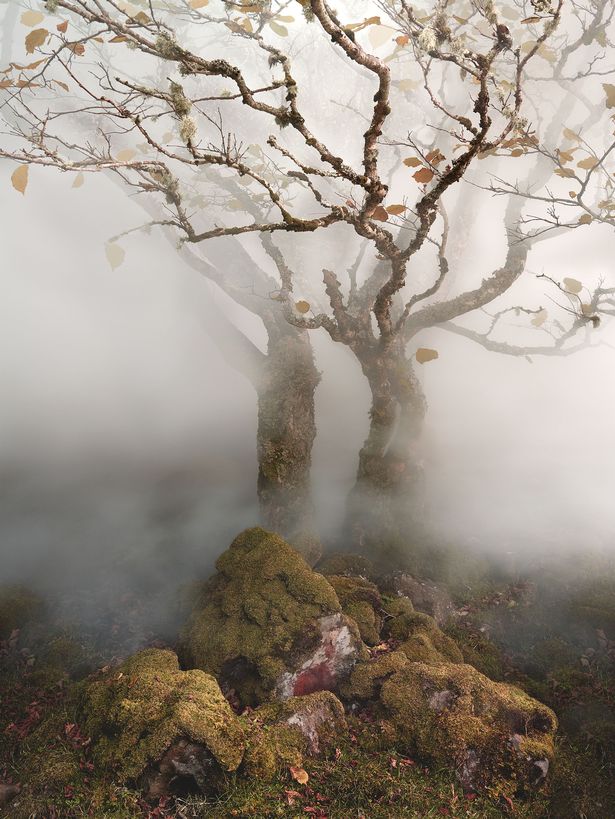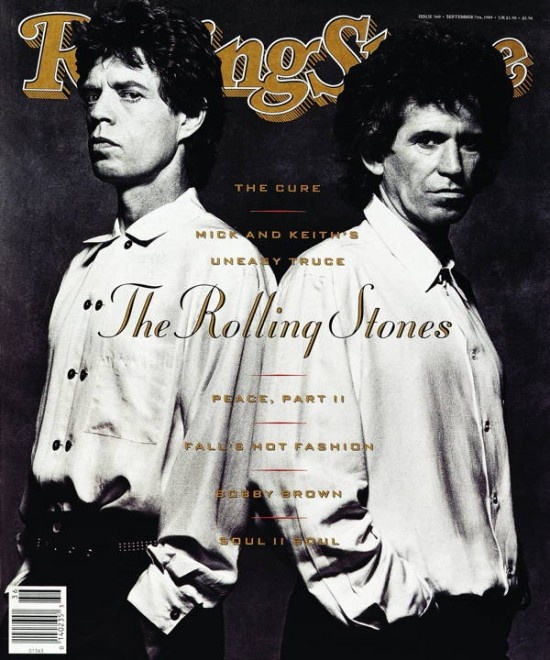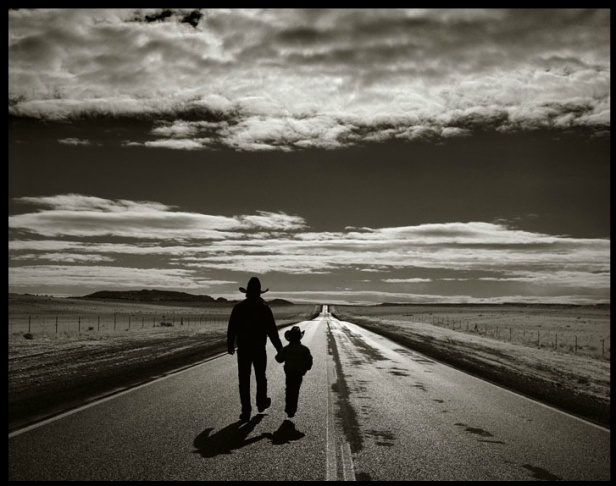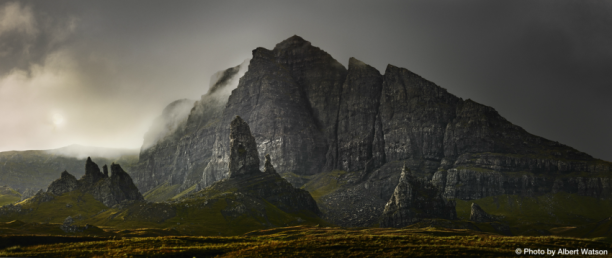By Bill Dobbins This photo of Alfred Hitchcock was a milestone in the career of Albert Watson. Photograph©Albert Watson A Cyclops in Greek and Roman mythology was a member of a race of giants with one eye set in the middle of its forehead.
Albert Watson uses this term to describe himself because he has been blind in one eye since birth and has had to navigate the world all his life without the benefit of stereoscopic vision. This would be a great disadvantage in activities where depth perception is essential such as ping pong, juggling or golf. But this turns out not to be the case in photography.
In fact, artist David Hockney, who has himself done a lot of photography, is of the opinion that a photography is by its nature limited because it captures the world in a split second, from a single, fixed point of view and in most cases representing a flat, two-dimensional plane. He has since revised this opinion because of the potential for a photographic artist to develop and layer his vision of time using digital technology, but he view is that the camera is essentially a Cyclops.
Just like Albert Watson.
One thing celebrities, like Clint Eastwood, like about Albert Watson is that he tends to work very fast and not waste time. Photograph©Albert Watson What has Watson achieved as a photographer? This is what
Wikipedia reports about him:
Albert Watson is a Scottish photographer well known for his fashion, celebrity and art photography, and whose work is featured in galleries and museums worldwide. He has shot over 100 covers of Vogue around the world and 40 covers of Rolling Stone magazine since the mid-1970s. Photo District News named Watson one of the 20 most influential photographers of all time, along with Richard Avedon and Irving Penn, among others.[1] [2] [3] [4] [5]
Pretty amazing, one-eye or not.
An amazing image in which Watson super imposed the face of a leopard on that of Mike Jagger. Photograph©Albert Watson Watson has shot fashion, celebrities, events and almost any subject you can mention. However, he says, “I try to approach every single subject the same way. If I’m photographing Stonehenge, Tutankhamen’s artifacts in Egypt, or a movie star like Clint Eastwood, I don’t really have a different way of approaching each. My goal is the same. I’m after an image that has
power .”
This is why Watson’s photos have often been described as “heroic” or “iconic.” Images that grab the eye and stick in the mind. Pictures to be remembered. After all, if photos are being used to tell a story, to record an event or to promote and market a product or career, unless they grab the eye and are remembered they are not going to be very effective.
Steve Jobs photographed by Albert Watson. Two icons working together. Photograph@Albert Watson Christy Turlington is another supermodel whom Albert Watson has shot during the course of his career. Photo©Albert Watson Albert Watson is incredibly well known and respected by the industries from where his clients come, but much less known to the general public than some other great photographers. Annie Leibovitz is practically a household name nowadays. Many non-aficionados recognize names like Penn, Avedon, Helmut Newton or Herb Ritts. But a lot of incredibly successful and influential photographers like Watson or
Harry Benson tend to fly under the radar where public fame is concerned.
They probably are perfectly happy this is the case. Being successful in their work means they get lots more work, access to a wider range of subjects and are paid very well. But not being a well known public figures results in fewer people taking up their time and bothering them. You can’t sign autographs and shoot photos at the same time.
Albert Watson grew up in the beauty of the landscapes of Scotland and still loves to capture photos of natural beauty. Photograph©Albert Watson “I don’t know how having sight in only one eye has affected my photography,” he says. But seeing only in two dimensions and shooting photographs that are two-dimensional might give him an advantage in terms of graphic intensity and compositional power. But it is clear that the impact of the style of photos he creates has always been very distinctive and memorable – with a strength, clarity, and masculinity that is clearly Albert Watson.
Albert Watson is known for his meticulous approach to getting everything right, to attention to detail. This is true in terms of his super-organized studio, the quality of his images and results in part from his highly dedicated work ethic. But he explains this is something he has learned, necessary to achieving and maintaining his success but not really inherent in his nature. He is very leery of striving for “perfection.” After all, nothing is ever really perfect. Perfection is an abstract ideal and unattainable. And, as they say, in practical terms the perfect is often the enemy of the good.
Mick Jagger and Keith Richards weren’t getting along but Albert Watson got them to pose together and the result clearly illustrates their relationship. Credit: Albert Watson But part of the way you get great results is by making the effort to get them. For example, Watson was asked to shoot a cover for
Rolling Stone with the Rolling Stones. He was cautioned against asking Mike Jagger and Keith Richards to pose together because they weren’t really getting along. But at the end of the shoot, he invited them onto the set together and got an image of them back to back, looking over their shoulders and kind of scowling. A terrific illustration of their real relationship.
Of course, that is what made it onto the magazine cover. An example of: you don’t ask, you don’t get.
Portrait of Tupac Shakur. Photography©Albert Watson Shooting photos of The Stones, Clint Eastwood, Tupac or Alfred Hitchcock is a long way from making pictures of his little sister with a box camera back in Scotland when he was 14. But he recalls being in a school that believed in fostering the inner creativity of a child and believes what he learned in those formative years has stuck with him and helped him to achieve the great success as a photographer he has experienced.
“I actually had the benefit of going to art college and getting a really broad art education back in 1962 to 1964,” Watson recalls.” “I did a lot of drawing, painting, fabric design and graphic design. For some reason, graphic design got a hold on me and that’s what I decided to specialize in. Then they brought in a photography teacher and you could do photography as part of graphic design studies.”
“When I got hold of a camera something happened to me, like a bolt of lighting and from that time on I became really obsessed by shooting photographs.”
Watson got various scholarships and fellowships but what really changed his life was when his wife Elizabeth got a teaching job in Los Angeles. He had visited New York some time before, liked America so he decided to accompany his wife to California with no real employment prospects. But he did use his time to continue shooting photos so he had the beginnings of a portfolio. A friend of his got him hooked up with an art director for Max Factor who booked a model for him, provided a rack of fashions and had him do some test photos.
The test shoot was supposed to be for an hour but actually took about 12 hours as Watson continued taking photos and ended up spending most of his savings on film and processing. He went back to the art director carrying 68 rolls of film. The people at Max Factor loved the images and Watson ended up being paid $6000 – in 1970s money – a fortune as far as he was concerned. Then the company later bought two more and his total compensation for the photos session was a cool $9000!
This initial photo sale, says Albert Watson, totally changed his life.
Graphically striking and compelling – the hallmark of an Albert Watson photo. Photography©Albert Watson Photography©Albert Watson Photograph©Albert Watson Watson also enjoys going back to Scotland and photographing landscapes, many of which he considers among the most beautiful in the world. As many years as it has been since he left his native land, he still gets the feeling of coming home each time he returns.
[caption id="" align="alignnone" width="612"]
Photography@Albert Watson[/caption]
Albert Watson is known for a certain kind of iconic portrait but the range and styles reflected in his portfolio are varied and extensive. He can shoot on location as well as in the studio, work in color and BW, do fashion and nudes and often make use of props, angles and other photographic ideas to make his images as memorable as he can. Nothing bores a really creative photographic artist more than shooting boring pictures.
Another thing that characterizes the career of Albert Watson is that
he never stops shooting. From his start in 1970 to the present he says he is always taking photographs, whether on assignment or for his own artistic goals and purposes. Most really successful people, especially in the arts, often tend to be obsessive about their work, feeling uneasy if they don’t have a paintbrush or pencil in their hands, some clay to mold or stone and a chisel – or in the case of Albert Watson a camera in his hands.
A different kind of celebrity. Photograph©Albert Watson “More recently,” explains Watson, “I’m looking back over my body of work. You end up shooting photos for magazines or other clients that they decide not to use. So I like going back over 40 years worth of images and choosing unpublished photos that I think are terrific but were labeled as a kind of “road kills” and got consigned to the filing cabinet. It is amazing some of the powerful work I can rescue this way.”
Some of these “rescued” photos end up being exhibited in galleries and other are published in photo art books, of which Albert Watson has a half a dozen. There is also a demand for his custom prints, including some really fabulous prints done in beautifully executed platinum.
Photograph©Albert Watson Photograph©Albert Watson Photograph©Albert Watson Albert Watson is a believer in talent. Some people are born with the ability to do things well that others are not. And there was certainly an automatic, natural connection when he first held a camera that indicates he was evidently born to be a photographer. But he also recognized the importance of the “ten thousand hours rule” author Malcolm Gladwell talks about in his book
Outliers .
“There’s a certain something,” he explains,”a sheer power you get from keeping on going, continuing to work, developing skills over time that allows you to reach a very comfortable, fluent level of ability and expertise.” For a photographer, there comes a point where he or she don’t really have to think and calculate when setting up a shot – at least, not to a great degree – where they can rely on the feel and intuition developed over decades.
But that is not the same as containing to do things the same way and getting the same results. Albert Watson is always looking for a way to make his images more immediate and powerful. He is also an accomplished director and so a master of motion as well as still photography.
Watson has also embraced the digital age. He not only shoot with digital cameras but has become highly adept at using Photoshop and collaborating with those who are truly masters of the software. Watson is certainly proud of the work he has done in the past and enjoys sharing those classic images.
Photograph©Albert Watson But like most master photographers, the most important photography to him – is the next one he shoots!
COMING SOON: Albert Watson’s new Taschen book
Kaos due out in late April (and three years in the making), and exhibitions in Cannes, France (Opiom Gallery); Vienna, Austria (Preiss Fine Arts); and Paris (A. Galerie), along with numerous group shows (Seoul and Hong Kong) and participation at the AIPAD photography fair at the end of March. Albert is also giving two presentations at The Photography Show in Birmingham, U.K. later this
month .
Learn more about Albert Watson and his work on his website:
•••••••••••••••••••••••••••••••••••••••••••••••••••••••••
Bill Dobbins is a pro photographer located in the Westwood area of Los Angeles. He is a veteran photographer and videographer who has exhibited his fine art in two museums and a number of galleries and who has published eight books, including two fine art photo books:
WEBSITES
Photograph©Albert Watson Photograph©Albert Watson
























